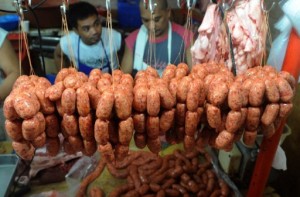
A vendor sells pork sausage in Manila's farmers market on November 4, 2011. Philippine inflation in December settled at 4.2 percent year on year, its lowest level in 11 months as consumer prices dropped by 0.2 percent in December, according to government data released Thursday, Jan. 5, 2012. AFP PHOTO/JAY DIRECTO
The country’s annual inflation eased in December to its lowest level in 11 months, raising expectations that the Bangko Sentral ng Pilipinas would cut policy rates early in the new year to support growth amid doubts over the pace of the global economic recovery.
That month, inflation settled at 4.2 percent year on year. As a result, inflation in 2011 averaged at 4.8 percent, according to government data released Thursday.
The 2011 inflation figure is well within the government’s target range of between 3 and 5 percent for the full year, said the National Economic and Development Authority (NEDA).
The annual headline inflation in December was based on a new data series using 2006 prices. The index rose 4 percent under the old data series, with 2000 as the base year, matching the low end of the central bank’s forecast of 4.0 to 4.9 percent for December.
In forecasting inflation, the BSP will switch to the 2006 data series this January. The government said it would soon announce its 2012 and 2013 inflation targets.
Now that inflation has become less of a worry, some analysts believe that the BSP will deliver a 25-basis-point cut when members of its Monetary Board meet on January 19.
Inflation is the rate of increase in the average prices of a standard “basket” of goods and services that households regularly purchase.
According to the National Statistics Office, all commodity groups except furnishing, household equipment, and routine house maintenance; recreation and culture; and education indexes posted either slower annual increment or negative annual rate during the month.
Month on month, consumer prices dropped by 0.2 percent in December due to lower prices of heavily weighted food items such as rice, cooking oil, vegetables, and sugar in many regions including the National Capital Region (NCR).
“I think the numbers are a relief to the BSP as food price pressures do not appear to have materialized despite the crop damage,” said Eugene Leow, an economist at DBS in Singapore, referring to damage caused by a typhoon that hit southern Philippines last month.
“Another 50 basis points worth of rate cuts are pencilled in for the first half of the year. The first 25 basis points cut could certainly come as soon as the upcoming meeting in January,” Leow added.
The NSO said that the general downward adjustments in the prices of gasoline and diesel nationwide, along with lower electricity charges in the NCR, contributed to the decline in month-on-month inflation.
“The slowing inflation is good news. It is consistent with the view that growth, rather than inflation, should be the focus of policymakers,” Benjamin E. Diokno of the UP School of Economics said in a text message.
Diokno added that the lower inflation figure supported “the need for reducing policy interest rates to spur growth.”
On Wednesday, BSP Deputy Governor Diwa Guinigundo said that the stable inflation environment in 2011 was a cause for optimism.
As the purchasing power of the average Filipino appears to be generally unaffected by problems abroad, consumers will be encouraged to continue buying goods which, in turn, will support businesses and keep workers occupied.
Also, BSP Governor Amando Tetangco said the December inflation data reinforced the central bank’s view that inflation would remain manageable over the policy horizon, giving policymakers room to adjust interest rates if needed.
But authorities remain watchful of developments abroad, including geopolitical risks in the Middle East, because of their impact on inflation, he said. The Philippines imports most of its crude oil requirements from the Middle East.
“BSP will make adjustments as necessary to ensure that our monetary settings remain appropriate,” Tetangco said in a mobile text message to reporters.
In the year ahead, monetary authorities will continue to shepherd inflation to within 3 and 5 percent.
According to financial services firm DBS Group, Philippine inflation has already started to trend lower after peaking at 5.2 percent year on year in October, based on 2006 prices.
“Price pressures in the coming months should remain benign amid a slowing global economy,” the Singapore-based group said.
Despite higher food prices due to crop damage from recent bad weather, DBS expects Philippine inflation to trend toward 4 percent by March, and average at the same level throughout 2012.—With a report from Reuters